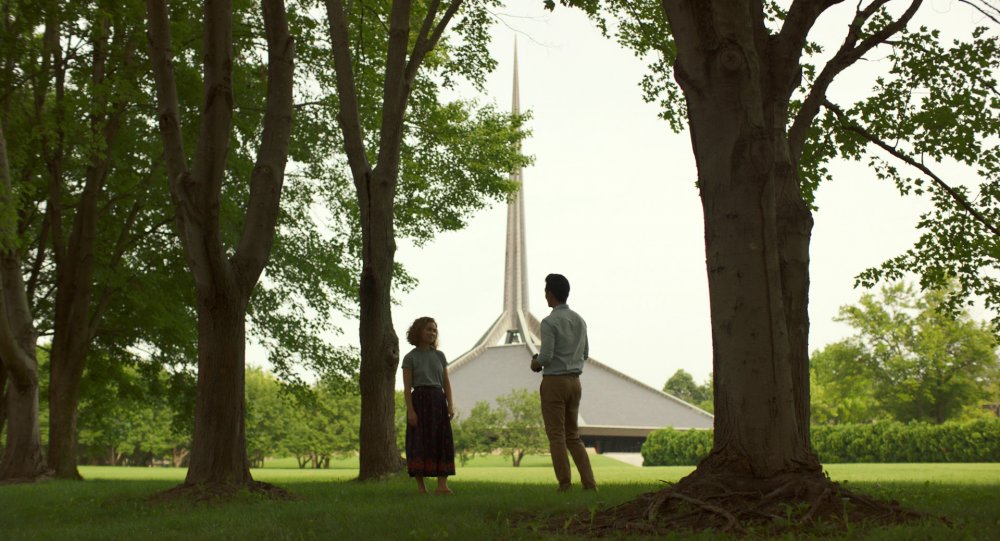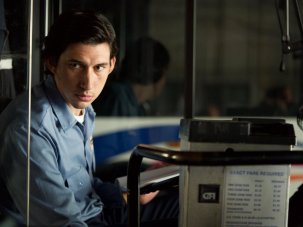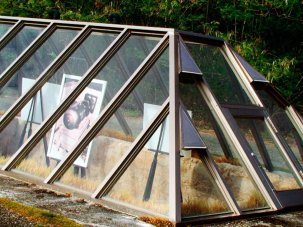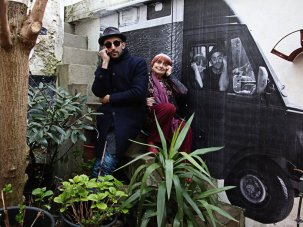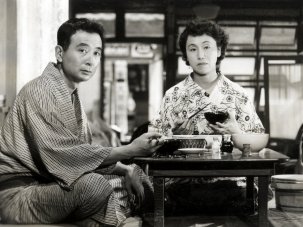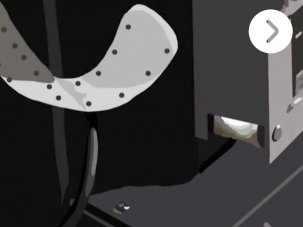Spoiler alert: this review reveals a plot twist
Haley Lu Richardson’s Casey is smoking a cigarette, considering Eliel Saarinen’s First Christian Church, a landmark in modernist architecture in Columbus, Indiana, and one of the earliest religious buildings envisaged in a contemporary style. This is where she meets John Cho’s Jin. Their ensuing conversation – candid, playful, quiet – sets the tone for Columbus, but it’s Casey’s insight into the design of the building in front of them that keeps coming to mind throughout this debut narrative feature from the filmmaker and writer Kogonada. “It’s asymmetrical,” she points out, “but it’s also still balanced.”
USA 2016
Certificate 12A 104m 1s
Director Kogonada
Cast
Jin John Cho
Casey Haley Lu Richardson
Maria Michelle Forbes
Gabriel Rory Culkin
Eleanor Parker Posey
[1.85:1]
Part-subtitled
UK release date 5 October 2018
Distributor Network Releasing
networkonair.com/features/columbus
► Trailer
It is perhaps unsurprising to those familiar with Kogonada’s acclaimed video-essay work, which often observes the subtle details and recurring motifs of auteurist vision, that his feature debut would be equally meticulous. A scene echoing the duo’s first meeting sees Jin proffer his own architectural wisdom – this time about James Stewart Polshek’s Mental Health Services building. He explains that all the details of the building are mindful of its core responsibility as a place of healing. Form follows function. For Kogonada, modernist architecture is as central a concern as the film’s more conventional themes, and a number of the principles of the movement permeate the visual, narrative and emotional construction of the film.
It may be a coming-of-age story with romantic overtones and an undercurrent of intergenerational conflict, but its simplicity and clarity are striking and assured. The delicate form grows from the characters and their relationships. Nothing is purely ornamental – what might be key moments in other films are here observed through glass, unheard.
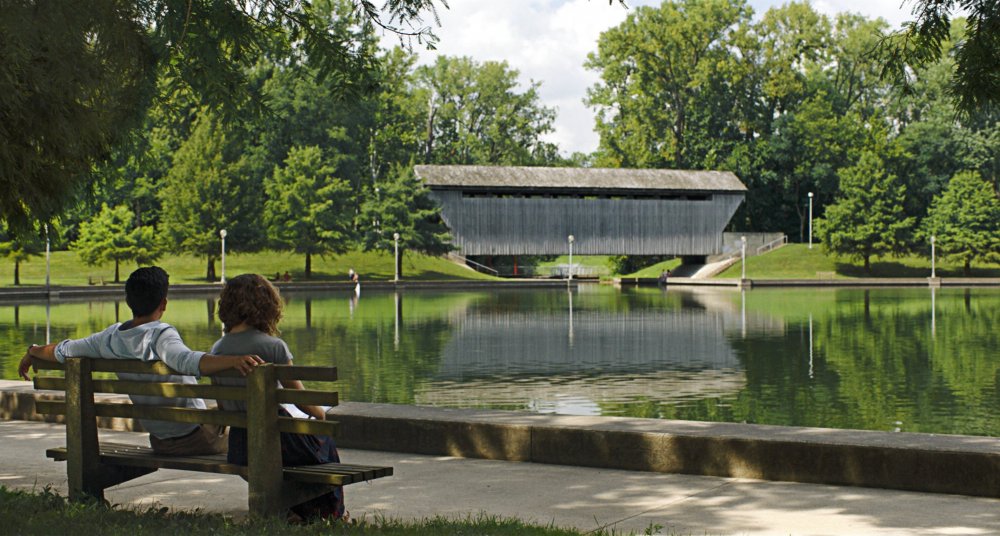
The images, shot by Elisha Christian, are artfully composed and brimming with rectangular and cubic shapes, consistently emphasising horizontal and vertical lines. It’s in the framing that the filmmakers’ adherence to Casey’s ‘asymmetrical balance’ is most obviously manifest. Often the placement of people within long shots of interiors or exteriors adds a note of asymmetry to a balanced vista: a book trolley trundling through the rows of shelves in a library; Jin and Casey off to one side on a flight of steps. Alternatively, in dialogue scenes, the characters can be perfectly placed for balance, while the architecture (always feeling like an active participant in the frame), or even the camera angle, intrudes to nix the symmetry. This happens right from the meet cute in which Jin and Casey walk along opposite sides of an iron fence, in step, with the camera angle askew. In another scene, they confide in one another over the roof of a car, while the off-centre placement of the building in the background disrupts the frame. This never creates the effect of unbalancing the compositions but it makes for a constant visual tension that underlies the discourse.
These graphic configurations share some similarities with the way that Japanese master Ozu Yasujirō shot space, and his influence is clear in other visual choices, such as the use of intermediary landscape shots between scenes and the regular crossing of ‘the line’ determining the acceptable space a camera can occupy in conventional shooting set-ups. (It should be noted that Kogonada takes his assumed name from Ozu’s screenwriting partner Kogo Noda.) The aforementioned intergenerational conflict is also drawn from Ozu, and gives another type of asymmetrical balance to Columbus.
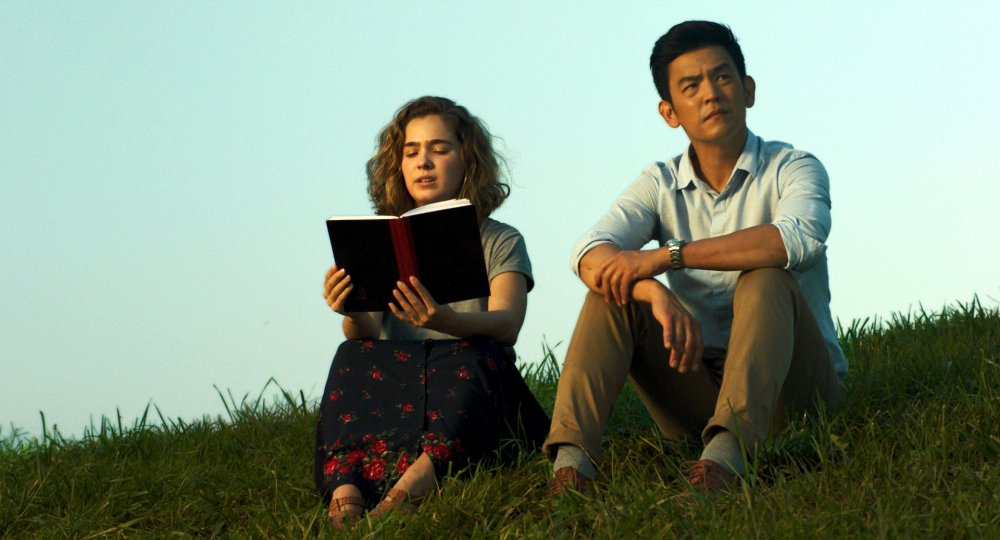
Their parents are the reasons that both Casey and Jin are in the city at all. Casey won’t leave because she feels a duty to look out for her mother (“That’s her real addiction – shitheads”), while Jin has flown in from Seoul to see his hospitalised father. They bond through these parental relationships, though their situations are almost mirror opposites. Both parents have selfishly neglected their children, but for Casey this has reinforced her love and given her a fear of distance, whereas in Jin it has opened a chasm and driven him away. In the context of these family dynamics, they are warmth and coldness personified, and each provides the other with the perfect antidote in the debate over how to move forward.
The film ends with a perfectly centred shot looking across the modernist Robert N. Stewart Bridge, and the mind casts back to a reference to one building as “a literal and metaphoric bridge”. The film acts as the same. It’s a connection and a transition – for the characters and the audience. From all the formal elegance there emerges something subtly but profoundly affecting about family and friendship. “Do you like this building intellectually, because of all the facts?” Jin asks Casey at one point. “No,” she answers, “it moves me.”
In the October 2018 issue of Sight & Sound
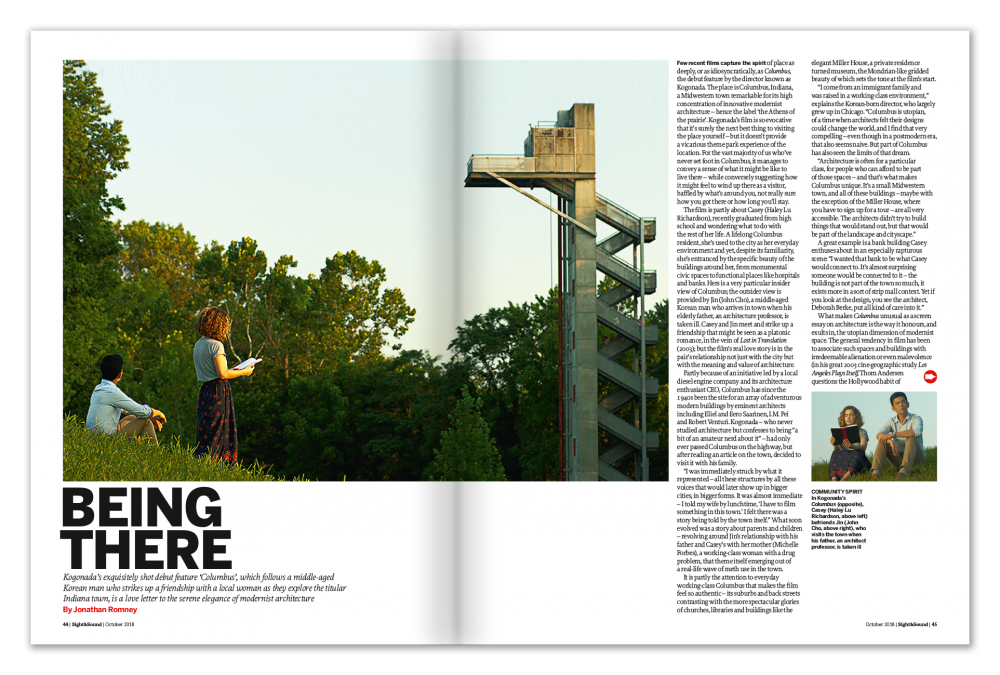
Being there
Kogonada’s exquisitely shot debut feature Columbus, which follows a middle-aged Korean man who strikes up a friendship with a local woman as they explore the titular Indiana town, is a love letter to the serene elegance of modernist architecture. By Jonathan Romney.
-
Sight & Sound: the October 2018 issue

Class in British cinema – plus Peterloo, Climax, The Miseducation of Cameron Post, Columbus, Elaine May and more.
-
The Digital Edition and Archive quick link
Log in here to your digital edition and archive subscription, take a look at the packages on offer and buy a subscription.




